Need to find an important message in your crowded Inbox or folder? Instant Search helps you to quickly find items in Outlook. The Instant Search pane is always available in all of your Outlook folders, such as Mail, Calendar, and Tasks.
For tips on getting even better search results with Instant Search, see the article Learn to narrow your search criteria.
What do you want to do?
-
In the navigation bar, near the bottom of the screen, click Mail.
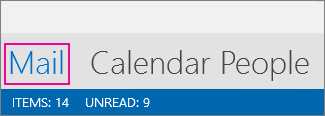
If you don't see this, "Compact Navigation" might be turned on, so you'll see icons instead, like this:
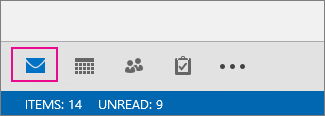
Or, in addition to "Compact Navigation" being on, the folder pane might be minimized, so the icons are arranged vertically. You can expand the folder pane by clicking the Minimize/Expand button, as shown here:
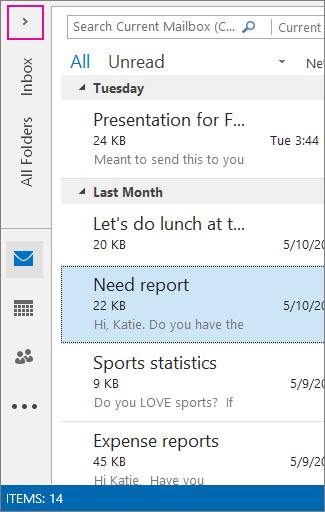
-
Find the search box. It’s at the top of your messages, as shown here:
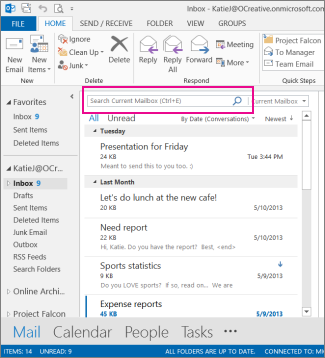
-
To find a word that you know is in a message, or a message from a particular person, type the word or person's name (you can use first, last, and partial names) in the search box. Messages that contain the word or name you specified appear with the search text highlighted in the results.
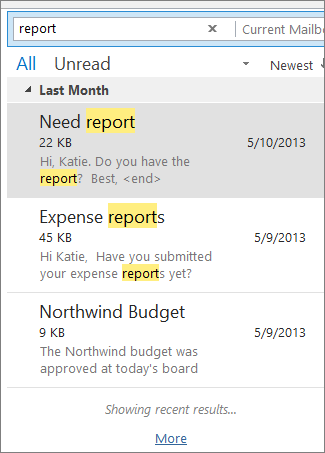
-
You can narrow your results even further by changing your search. Here are some common examples:
-
Type "expense reports" (including the quotes) to find messages containing the exact phrase "expense reports."
-
Type expense AND report ("AND" needs to be in all caps) to find messages containing both the word expense and the word report, but not necessarily in that order. You can also use "OR."
-
Type expense NOT report ("NOT" needs to be in all caps) to find messages containing the word expense but not the word report.
-
-
NOTE: Searching will only find items if you search for an entire word, or the beginning of a word; if you search for the middle or end of a word you will not find the item. For example, if the message subject contains "Email about Office365", the following searches will NOT find that item:
-
"mail" -- because this is the end of the word "email"
-
"365" -- because this is the end of the word "Office365"
-
"ice" -- because this is in the middle of the word "Office365"
-
-
When you’re finished, you can clear the search by clicking the

If you can’t find what you’re looking for, use the search tools on the ribbon to narrow down your search. When you click the search box, you can select a scope option on the left side of the ribbon. Once you decide your scope, you can then refine your search further by selecting an option such as the subject line or the sender.
Scope (where to search): Here you can choose to search in specific folders, such as all your mailboxes, or just the current folder you’ve selected, which is your Inbox most of the time.
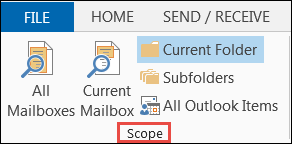
Refine (what to search for): When you’ve selected your scope, you can add other criteria in the Refine group. When you select an option, Outlook adds a special script to the search box to limit its search.

Let’s take a look at the options.
-
From: filters your search results to only show messages sent by a specific person. For example, you can search for all the messages sent by Sara.
-
Subject: filters your search results based on the subject line of the email. For example, you can search for all the messages that have the keyword “report” in the subject line.
-
Has Attachments: gives you all the messages that contain an attachment.
-
Categorized: choose a category to see all the messages that you’ve flagged with a specific category.
-
This Week: on the drop-down menu, choose a time frame to narrow your search results based on the time you received a message.
-
Sent To: on the drop-down menu, choose an option to filter the results based on the email recipients. For example the messages that you were CCed on, or the ones that were sent to a specific person.
-
Unread: brings up all the unread messages in the folder that you’ve selected.
-
Flagged: brings up messages that you flagged to follow up.
-
Important: shows all the messages that were marked with high importance.
-
More: choose an option on the menu to further narrow down your search results. For example you can filter by sensitivity or message size.
Remember that you can mix and match these options.
Here's an example: You can search for all the messages from Sara that you received last month, with the keyword “report” in the subject line.
To set up a search for this example:
-
Make sure Inbox is selected, then click in the Search box.
-
Select Subfolders in the Scope group.
-
Click From and type Sara to replace the highlighted text in the search box.
-
Click Subject and type report to replace the highlighted text in the search box.
-
From the drop-down menu next to This Week, select Last Month.

Getting too many results? Or are you just not finding what you want?
Note: Advanced Find is not available for auto-expanding archives. For more information about auto-expanding archives, see Office 365: Auto-Expanding Archives FAQ - Microsoft Community Hub.
-
Click in the search box.
-
On the Search tab, click Search Tools > Advanced Find.
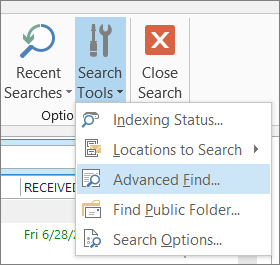
In the Advanced Find box, you can specify much more complex criteria and even search in your calendar, contacts list, notes, and tasks.
-
Click the Advanced tab.
-
Under Define more criteria, click the Field button and then click All Mail Fields. You'll see a menu of fields you can search on, such as From, To, Received, Subject, and dozens more.
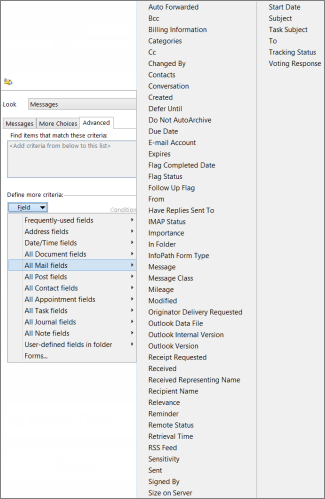
-
Start by choosing a field, then choose a condition and a value to test. For example:
From/ Contains/ Katie will search for messages from someone whose name includes "Katie." Notice we're using contains as the condition instead of is (exactly) so that we don't have to find an exact match. So if Katie's email name is "Katie Jordan," From/is (exactly)/Katie won't work because we'd need to specify Katie's full name, Katie Jordan, to get an exact match. That's where contains comes in handy as a condition.
-
Add as many additional conditions as you need or want to test. We'll add three more:
From | Contains | Katie will search for messages from someone whose name includes "Katie." Notice we're using contains as the condition instead of is (exactly) so that we don't have to find an exact match. So if Katie's email name is "Katie Jordan," From | is (exactly) |Katie won't work because we'd need to specify Katie's full name, Katie Jordan, to get an exact match. That's where contains comes in handy as a condition.
Then, let's say you add these as well:
-
Received | between | 5/01/13 and 5/31/13
-
Message | contains | budget
-
To | contains | Rob
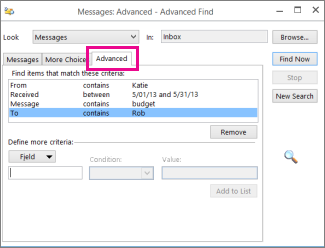
Now, Outlook searches for messages from someone with "Katie" in her name that arrived in the inbox in May, 2013, with "budget" in the message body, and (in addition to you) were also sent to someone with "Rob" in his name. Here's a zoomed look at the list of the four criteria we added.

Finally, click Find Now to run the search.
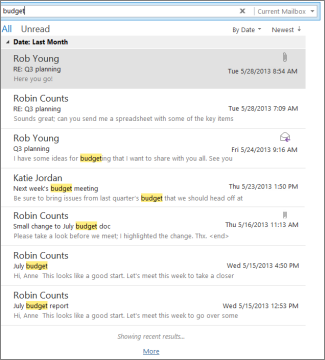
If the thought of more than 250 results doesn't scare you off, you can bypass that limit:
-
Click File > Options > Search.
-
Under Results, clear the Improve search speed by limiting the number of results shown check box.










